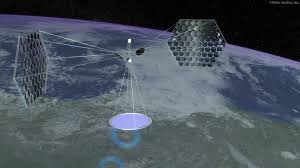





I myself am still pretty big on
Sahara though. Space might be 10 times more efficient, but it might be 20 times more expensive, at least now. But I will go to space for clean, why not? Space based solar power also has potential for colonizations of the moon and Mars and beyond. It would make large scale 3D printing possible. Ocean covered moons of planets like Jupiter could give water if energy is plentiful. Water and solar and you are that close to growing food.
Space-based solar power
a higher collection rate and a longer collection period due to the lack of a diffusing atmosphere and night time in space
Space-based solar power: the energy of the future?
In space there's no atmosphere, it's never cloudy, and in geosynchronous orbits it's never night: a perfect place for a solar power station to harvest uninterrupted power 24 hours a day, 365 days a year. ..... the concept is scientifically sound. ..... there was nothing wrong with the physics but the real question is the economics ...... With costs as high as $40,000 per kilogram for some space launches, the final price-tag for the first space-based solar power station could be as high as $20 billion. ........ the wars in the Middle East gave new impetus to the space-based solar power as scientific researchers with the military wrestled with the problems of delivering energy to troops in hostile areas. ........ Multiple, and potentially hidden, receivers could tap space-based solar power and relieve the military of the expensive and often dangerous task of supplying troops with generator diesel by either road or air ...... Two proven ways of getting the power to Earth exist in the form of either laser beams or microwaves. ...... laser transmitting satellites would have difficulty beaming power through clouds and rain. ...... The microwave option would have the advantage of uninterrupted transmission through rain, hail or any other atmospheric conditions and could provide gigawatts of power........ as early as 1964, scientists were able to power a helicopter using microwaves. Dr Jaffe said with a large receiving area the energy from the microwaves was so dissipated that it would present no danger to life. ......... as many as 100 launches into space would be required to construct the space stations with costs running into tens of billions. ...... space-based solar energy is like most novel ideas. "It's hard to tell if it's nuts until you've actually tried."
Space-Based Solar Power
Microwave transmitting satellites orbit Earth in geostationary orbit (GEO), about 35,000 km above Earth’s surface. Designs for microwave transmitting satellites are massive, with solar reflectors spanning up to 3 km and weighing over 80,000 metric tons. They would be capable of generating multiple gigawatts of power, enough to power a major U.S. city. ...... The long wavelength of the microwave requires a long antenna, and allows power to be beamed through the Earth’s atmosphere, rain or shine, at safe, low intensity levels hardly stronger than the midday sun. Birds and planes wouldn’t notice much of anything flying across their paths. ........ The estimated cost of launching, assembling and operating a microwave-equipped GEO satellite is in the tens of billions of dollars. It would likely require as many as 40 launches for all necessary materials to reach space. On Earth, the rectenna used for collecting the microwave beam would be anywhere between 3 and 10 km in diameter, a huge area of land, and a challenge to purchase and develop.
What If Giant Space-Based Solar Panels Could Beam Unlimited Power To The Earth?
This idea may sound like science fiction, and at one time it was. ...... Asimov's 1941 story envisions a world where the Earth is powered by a beam of light that draws its energy directly from the sun..... Take New York City, for example, which requires 20 gigawatts of power. ...... The sandwich modules would be about 10 feet long on a side and about 80,000 would be needed. The array of sandwich modules would be about the length of nine football fields, or more than 1/2 a mile long. This is about nine times bigger than the International Space Station...... Back on Earth, the energy-containing radio frequencies from the space-based solar panels would be received by a special antenna known as a "rectenna," which could be as big as six miles in diameter............ the same beam would be able to provide power to Seattle and redirected to provide power to Rio de Janeiro in Brazil...... they could build receivers at remote operating bases and locations where it is logistically difficult and incredible costly to deliver diesel fuel....... the incredible heat of the sun in space
China considering space-based solar power station
Some believe a space-based solar collector could be launched as early as 2020 ..... a satellite that weighs more than 10,000 lbs., dwarfing anything previously placed into orbit, including the International Space Station ...... others place the launch date further out, as far away 2050. ...... "China will build a space station in around 2020, which will open an opportunity to develop space solar power technology" ...... China should begin with an experimental space-based solar power station by 2030, and build a commercially viable space power station by 2050. ....... "An economically viable space power station would be really huge, with the total area of the solar panels reaching five to six square kilometers" ....... Six square kilometers is nearly twice the size of New York's Central Park. ....... The Japan Aerospace Exploration Agency (JAXA) has proposed its own solar collector to be launched within the next 25 years. ...... "When space solar energy becomes our main energy, people will no longer worry about smog or the greenhouse effect"
Space solar is a very real option, but it will not happen in time to tackle Climate Change. For that we need to rely on Earth Solar. Let's just use satellites for internet communication.







































